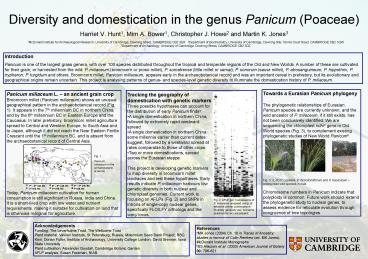Diversity and domestication in the genus Panicum Poaceae - PowerPoint PPT Presentation
1 / 1
Title:
Diversity and domestication in the genus Panicum Poaceae
Description:
Diversity and domestication in the genus ... A single domestication in northern China, followed by extremely ... or more domestications, spread across the ... – PowerPoint PPT presentation
Number of Views:42
Avg rating:3.0/5.0
Title: Diversity and domestication in the genus Panicum Poaceae
1
Diversity and domestication in the genus Panicum
(Poaceae)
- Harriet V. Hunt1, Mim A. Bower1, Christopher J.
Howe2 and Martin K. Jones3
1McDonald Institute for Archaeological Research,
University of Cambridge, Downing Street,
CAMBRIDGE CB2 3ER 2Department of Biochemistry,
University of Cambridge, Downing Site, Tennis
Court Road, CAMBRIDGE CB2 1QW 3Department of
Archaeology, University of Cambridge, Downing
Street, CAMBRIDGE CB2 3DZ
Introduction Panicum is one of the largest grass
genera, with over 100 species distributed
throughout the tropical and temperate regions of
the Old and New Worlds. A number of these are
cultivated for their grain, or harvested from the
wild P. miliaceum (broomcorn or proso millet),
P. sumatrense (little millet or samai), P.
sonorum (sauwi millet), P. atrosanguineum, P.
hippothrix, P. trypheron, P. turgidum and others.
Broomcorn millet, Panicum miliaceum, appears
early in the archaeobotanical record and was an
important cereal in prehistory, but its
evolutionary and geographical origins remain
uncertain. This project is analysing patterns of
genus- and species-level genetic diversity to
illuminate the domestication history of P.
miliaceum.
Panicum miliaceum L. an ancient grain
crop Broomcorn millet (Panicum miliaceum) shows
an unusual geographical pattern in the
archaeobotanical record (Fig. 1). It appears in
the 7th millennium BC in northern China, and by
the 6th millennium BC in Eastern Europe and the
Caucasus. In later prehistory, broomcorn millet
agriculture spread to Central and Western Europe,
to South Asia and to Japan, although it did not
reach the Near Eastern Fertile Crescent until the
1st millennium BC, and is absent from the
archaeobotanical record of Central
Asia. Today, Panicum miliaceum
cultivation for human consumption is still
significant in Russia, India and China. It is a
short-lived crop with low water and nutrient
requirements, making it suitable for cultivation
on land that is otherwise marginal for
agriculture.
- Tracking the geography of domestication with
genetic markers - Three possible hypotheses can account for the
distribution of early Panicum findsa - A single domestication in northern China,
followed by extremely rapid westward spread - A single domestication in northern China some
millennia earlier than current dates suggest,
followed by a westward spread at rates comparable
to those of other crops - Two or more domestications, spread across the
Eurasian steppe - This project is developing genetic markers to map
diversity in broomcorn millet landraces and test
these hypotheses. Early results indicate P.
miliaceum harbours low genetic diversity in both
nuclear and chloroplast genomes. Current work is
focusing on AFLPs (Fig. 2) and SNPs in introns of
single-copy nuclear genes, specifically FLO/LFY
orthologs and the waxy locus.
Fig. 1. Panicum miliaceum in the
archaeobotanical reords
Fig. 2. AFLP gel 3 accessions of P. miliaceum
analysed using 16 selective primer combinations.
Diversity generally low, but some polymorphic
loci are present.
Acknowledgements Funding The Leverhulme Trust,
The Wellcome Trust Plant material Vavilov
Institute, St Petersburg, Russia Millennium Seed
Bank Project, RBG Kew Dorian Fuller, Institute
of Archaeology, University College London David
Brenner, Iowa State University Plant cultivation
Alexander Goodall, Cambridge Botanic Garden AFLP
analysis Susan Freeman, NIAB
References aMK Jones (2004) Ch. 10 in Traces of
Ancestry studies in honour of Colin Renfrew (ed.
MK Jones). McDonald Institute Monographs bSS
Aliscioni et al. (2003) American Journal of
Botany 90 796-821

